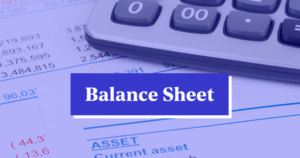Have you ever felt lost reading a company’s financial report? Among these documents, the income statement is the clearest roadmap to profitability. This guide breaks it down into simple parts—what it is, why it matters, and how to analyse it. For anyone in business, finance, or investing, understanding the income statement is a core skill to gauge performance.

What Is an Income Statement? (The ‘P&L’ Explained)
At its core, an income statement is one of the three principal financial statements used by companies to report on their financial performance over a specific accounting period (e.g., a quarter or a year). It provides a detailed summary of how the business incurs its revenues and expenses through both operating and non-operating activities. It is the primary document that shows a company’s profitability.
The Core Purpose: A Snapshot of Profitability Over Time
The income statement shows whether a company made or lost money in a given period. Starting with revenue and subtracting all costs, it arrives at net income—the ‘bottom line’ that signals financial health and efficiency.
Why It’s Also Called the Profit and Loss (P&L) Statement
Income statement and Profit and Loss (P&L) statement are interchangeable terms. Both tally all income and expenses to show final profit or loss. Other names include Statement of Operations or Statement of Earnings.
Income Statement vs. Balance Sheet vs. Cash Flow Statement
To fully grasp the role of the income statement, it’s helpful to compare it with the other two core financial statements. While the income statement shows performance over a period, the balance sheet provides a snapshot of a company’s financial position at a single point in time, and the cash flow statement tracks the movement of cash. Each answers a different fundamental question about the business.
| Financial Statement | What It Shows | Time Frame | Key Formula |
| Income Statement | Financial Performance & Profitability | Period of Time (e.g., Quarter, Year) | Revenues – Expenses = Net Income |
| Balance Sheet | Financial Position | A Single Point in Time | Assets = Liabilities + Equity |
| Cash Flow Statement | Cash Movements | Period of Time (e.g., Quarter, Year) | Beginning Cash + Cash Flow = Ending Cash |
The Key Components of an Income Statement: A Detailed Breakdown
A multi-step income statement presents information in a logical order, flowing from top to bottom. Understanding each component is crucial for a thorough analysis.

Revenue (The ‘Top Line’)
Revenue, often called sales, is the first line item on the income statement, hence the term ‘top line’. It represents the total amount of money generated from the sale of goods or services related to the company’s primary operations. Analysts look for consistent revenue growth as a sign of a healthy, expanding business.
Cost of Goods Sold (COGS)
COGS includes the direct costs attributable to the production of the goods or services sold by a company. This can include raw materials and direct labour costs. It does not include indirect expenses like marketing or administrative salaries. A rising COGS relative to revenue can signal pressure on profitability.
Gross Profit (Revenue – COGS)
Gross profit is a key profitability metric calculated by subtracting COGS from Revenue. It assesses a company’s efficiency at using its labour and supplies in producing goods or services. A stable or increasing gross profit margin (Gross Profit / Revenue) is a positive indicator of a company’s financial health.
Operating Expenses (Selling, General & Administrative)
Operating expenses (SG&A) are costs not tied to production, such as salaries, rent, utilities, and marketing. They are essential for running the business but not linked to individual units sold.
Operating Income (EBIT)
Operating Income is calculated by subtracting operating expenses from the gross profit. It shows how much profit a company generates from its core business operations, before accounting for interest and taxes. For this reason, it is also known as EBIT (Earnings Before Interest and Taxes). It’s a crucial measure of a company’s operational efficiency and profitability.
Non-Operating Items (Interest and Taxes)
This section includes revenues and expenses not related to the company’s main business activities. The two most common items are interest expense (the cost of borrowing money) and income tax expense. Other examples could include gains or losses from the sale of an asset.
Net Income (The ‘Bottom Line’)
Net income is the final amount of profit remaining after all expenses—including taxes and interest—have been deducted from all revenues. It is located at the bottom of the income statement, earning it the nickname ‘the bottom line’. This figure is arguably the most-watched number in a company’s financial reports, as it represents the profit available to shareholders.
How to Read and Analyse an Income Statement in 4 Simple Steps
Analysing an income statement involves more than just reading the numbers. It’s about interpreting them to understand the story they tell about a company’s performance. Here’s a straightforward four-step process.
Step 1: Start at the Top Line (Analyse Revenue Growth)
Begin your analysis with the revenue figure. Is it growing, stagnant, or declining over multiple periods (quarter-over-quarter or year-over-year)? Strong, consistent revenue growth is a primary indicator of a healthy company. Compare this growth rate to industry competitors to see if the company is gaining or losing market share.
Step 2: Calculate Key Profit Margins (Gross, Operating, and Net)
Profit margins reveal efficiency. Key ratios:
- Gross Profit Margin = (Gross Profit / Revenue) x 100 → production efficiency
- Operating Profit Margin = (Operating Income / Revenue) x 100 → core operations
- Net Profit Margin = (Net Income / Revenue) x 100 → final profitability
Tracking these over time is more useful than a single period.
Step 3: Scrutinise Operating Expenses and Efficiency
Look at the operating expenses (SG&A) as a percentage of revenue. Is the company keeping its overheads under control as it grows? If operating expenses are growing faster than revenue, it could be a red flag that the company is becoming less efficient, which will eventually erode profitability.
Step 4: Arrive at the Bottom Line (Evaluate Net Income Trends)
Finally, examine the net income. Is it consistently positive and growing? Be wary of one-off events (like the sale of an asset) that might inflate net income in a single period. The quality of earnings is important; look for steady growth from core operations rather than non-recurring gains. This final figure is what informs key metrics like Earnings Per Share (EPS), which is vital for stock valuation.
Single-Step vs. Multi-Step Income Statement: What’s the Difference?
Companies can choose between two formats for their income statement: single-step and multi-step. The choice largely depends on the complexity of the business and the level of detail required by its users.

The Single-Step Income Statement: Simplicity for Small Businesses
The single-step format is the simpler of the two. It calculates net income in one step by grouping all revenues and gains together and subtracting all expenses and losses. It’s often used by small businesses and sole proprietorships due to its ease of preparation.
Formula: Total Revenues – Total Expenses = Net Income
The Multi-Step Income Statement: Detailed Insights for Analysts
The multi-step format separates operating from non-operating items and calculates Gross Profit, Operating Income, and Net Income. Public companies prefer it for the detailed insights it offers analysts and investors.
Example Multi-Step Structure:
- Revenue:
$500,000
- Less: COGS:
($200,000)
- Gross Profit:
$300,000
- Less: Operating Expenses:
($100,000)
- Operating Income:
$200,000
- Less: Interest & Taxes:
($50,000)
- Net Income:
$150,000
Why the Income Statement is Crucial for Traders and Investors
For those actively involved in the financial markets, the income statement is an indispensable tool. It forms the bedrock of fundamental analysis, helping traders and investors make educated decisions rather than speculating.
Assessing a Company’s Core Performance and Profitability
The income statement directly answers the most important question: Is the company profitable? By examining gross, operating, and net profit margins, an investor can assess the quality of a company’s earnings and its operational efficiency. A company with consistently high and stable profit margins is often a more reliable investment.
Identifying Financial Trends to Forecast Future Growth
A single income statement provides a snapshot, but the real power comes from analysing trends over several periods. By comparing income statements from the past few quarters or years, an investor can identify patterns in revenue growth, expense management, and profitability. These trends are critical for forecasting a company’s future performance and estimating its potential stock price trajectory.
Making Informed Decisions When Trading Company Stocks
Understanding an income statement is vital for fundamental analysis. This helps traders on platforms like Ultima Markets evaluate whether a company’s stock is a sound investment. For instance, if a company’s income statement shows rapidly growing revenues and expanding profit margins, it may be considered a strong candidate for a long position.
Conversely, declining profitability could be a major red flag. This data-driven approach, supported by powerful tools on platforms like Ultima Markets MT5, enables traders to move beyond simple price charts and make decisions based on the underlying health of the business.
The confidence gained from such thorough analysis is invaluable, complementing the security measures brokers provide, such as robust Ultima Markets fund safety protocols, and is often reflected in positive Ultima Markets reviews. Once an opportunity is identified, straightforward processes for Ultima Markets Deposits & Withdrawals allow for efficient capital deployment.
Conclusion
The income statement shows how a company generates profit, from revenue to net income. More than an accounting document, it is a key tool for managers, investors, and traders to gauge financial health. Mastering its analysis turns you from a passive reader into an informed decision-maker.
Apply this skill by studying quarterly or annual reports. For traders, it sharpens strategy and reveals the story behind a company’s performance and growth potential.

FAQ
Q:What are the 3 main parts of an income statement?
The three main parts are Revenues, Expenses, and Net Income. The multi-step format further breaks this down by calculating Gross Profit and Operating Income before arriving at the final Net Income figure.
Q:Is an income statement the same as a P&L?
Yes, the terms ‘income statement’ and ‘Profit and Loss (P&L) statement’ are used interchangeably. They both refer to the financial report that summarises a company’s revenues, costs, and expenses over a specific period.
Q:How often is an income statement prepared?
Publicly traded companies are required to prepare and release income statements quarterly (every three months) and annually. Private companies may prepare them more frequently, such as monthly, for internal management purposes.
Q:What is the first item listed on an income statement?
The very first item listed on an income statement is Revenue (or Sales). This is why it is commonly referred to as the ‘top line’.
Q:What are the limitations of an income statement?
While powerful, the income statement has limitations. It does not show a company’s cash flow, as some revenues may be recorded before cash is received (accrual accounting). It also doesn’t provide a view of a company’s assets and liabilities, which is the purpose of the balance sheet. For a complete picture, it must be analysed alongside the balance sheet and cash flow statement.




